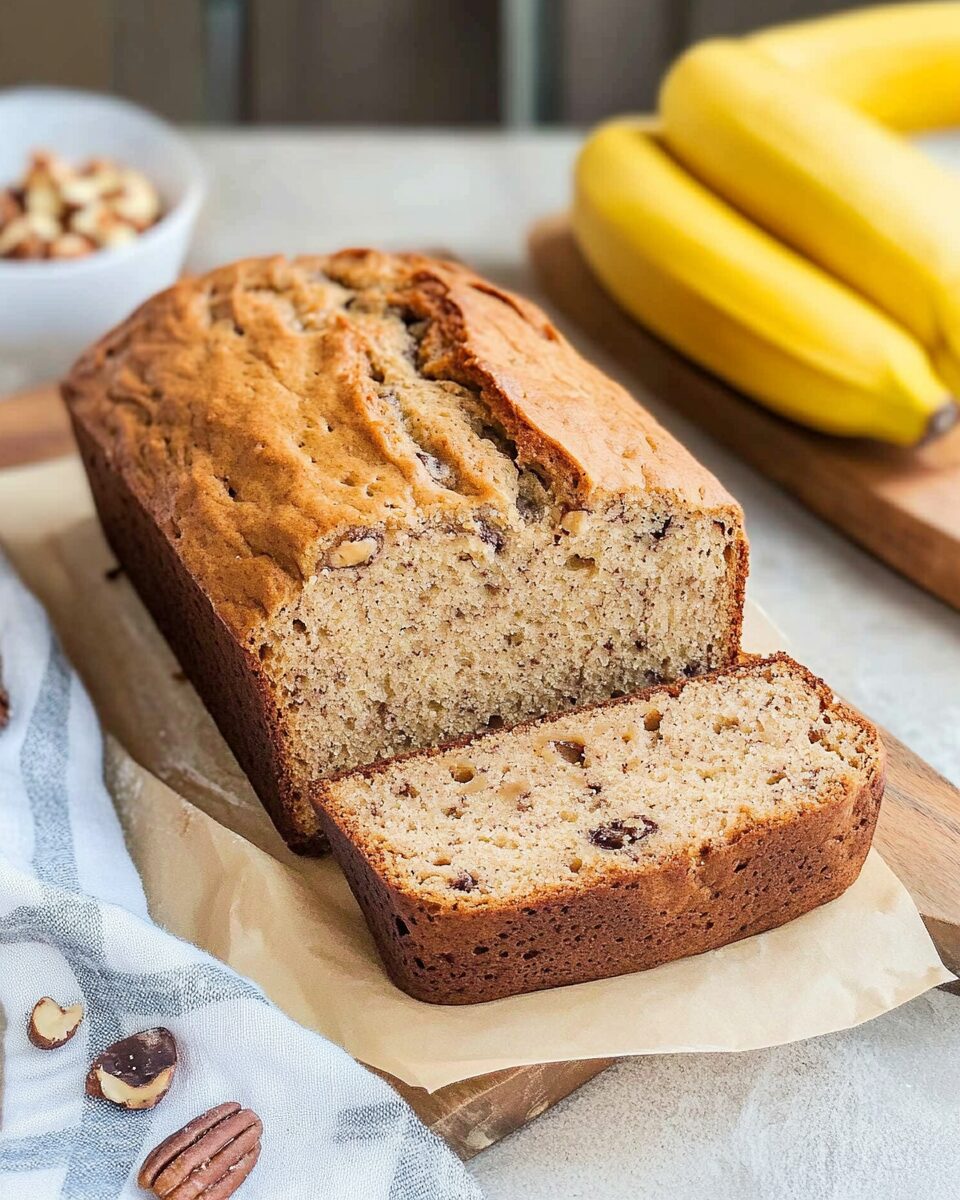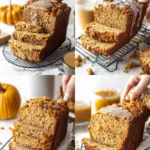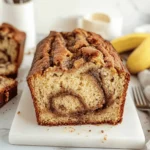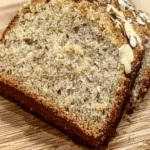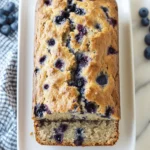This soft and moist banana bread is made effortlessly in a bread machine, delivering a warm, tender loaf every time. With ripe bananas and simple pantry ingredients, this recipe is perfect for a quick breakfast or a sweet snack.
FULL RECIPE
Ingredients
- 2 medium ripe bananas, mashed
- 2 large eggs
- 1/3 cup vegetable oil
- 1/2 cup granulated sugar
- 1/4 cup brown sugar, packed
- 1/4 cup milk
- 1 1/2 teaspoons vanilla extract
- 1 1/2 cups all-purpose flour
- 1 teaspoon baking powder
- 1/2 teaspoon baking soda
- 1/2 teaspoon salt
- 1/2 teaspoon ground cinnamon (optional)
- 1/2 cup chopped walnuts or chocolate chips (optional)
Directions
- Add mashed bananas, eggs, vegetable oil, sugar, brown sugar, milk, and vanilla extract to the bread machine pan.
- Add flour, baking powder, baking soda, salt, and cinnamon on top of the wet ingredients.
- Add optional nuts or chocolate chips if using.
- Set the bread machine to the “Quick Bread” or “Cake” setting.
- Start the machine and allow it to mix and bake as programmed.
- Once finished, remove the pan from the machine and let the bread cool in the pan for 10 minutes.
- Turn the bread out onto a wire rack and allow to cool completely before slicing.
Nutritional Information
- Calories: 220 per slice (based on 10 slices)
- Carbohydrates: 32g
- Protein: 3g
- Fat: 9g
- Saturated Fat: 1.5g
- Sugar: 17g
- Fiber: 1g
- Sodium: 220mg
The History and Origins of Banana Bread
Banana bread became popular in the United States during the 1930s, particularly as a way to use overripe bananas and reduce food waste during the Great Depression. Its rise in popularity coincided with the widespread availability of baking powder and baking soda, which enabled quick bread recipes to become household staples. Over time, banana bread has evolved from a simple way to use leftover fruit into a beloved comfort food that can be customized with nuts, chocolate, or spices.
Why Use a Bread Machine for Banana Bread
Using a bread machine to make banana bread offers convenience and consistency. The bread machine automates the mixing, kneading, and baking processes, ensuring even cooking and saving time for the baker. It’s especially helpful for beginners or those with limited kitchen experience because it reduces the number of steps and minimizes the chance of overmixing or underbaking.
Choosing the Right Bananas
The ripeness of bananas greatly affects the flavor and texture of banana bread. Overripe bananas with brown spots are sweeter and softer, which enhances the natural sweetness and moisture of the bread. Using underripe or just ripe bananas can result in a less flavorful, drier loaf. Many bakers recommend letting bananas ripen on the counter until they are heavily speckled or even turning mostly brown.
The Role of Oil in Softness
Oil, rather than butter, is often used in banana bread recipes to keep the loaf moist and tender. Vegetable oil or canola oil helps retain moisture better during baking, resulting in a softer crumb. Unlike butter, which solidifies when cooled and can make the bread denser, oil remains liquid, giving a lighter texture.
Eggs as a Binding and Leavening Agent
Eggs provide structure to banana bread by binding the ingredients together. They also contribute to leavening, helping the bread rise during baking. In bread machine recipes, eggs are especially important because they assist the machine’s kneading process, ensuring the batter is properly emulsified and smooth.
The Science Behind Baking Powder and Baking Soda
Baking powder and baking soda are key leavening agents in banana bread. Baking soda reacts with the acidic components of the bananas and brown sugar, producing carbon dioxide bubbles that make the bread rise. Baking powder contains both acid and base components and helps ensure the bread has a light, fluffy texture. The balance between these two ingredients is critical to avoid overly dense or crumbly bread.
Milk’s Contribution to Flavor and Texture
Milk adds moisture and richness to banana bread, helping create a tender crumb. It also reacts with the leavening agents to aid in the rise. Whole milk is preferred for added flavor, but lower-fat milk varieties can be substituted with minimal impact on texture.
The Importance of Vanilla Extract
Vanilla extract enhances the flavor of banana bread by adding warmth and depth. Even a small amount complements the natural sweetness of bananas and balances the flavors in the loaf. It is a subtle yet essential ingredient for a well-rounded taste profile.
Cinnamon and Spice Variations
Adding cinnamon or other warm spices such as nutmeg or allspice introduces complexity and a cozy aroma to banana bread. These spices pair well with bananas and can be adjusted to taste. Some variations include ginger or cardamom for a unique twist.
Optional Add-ins: Nuts, Chocolate Chips, and More
Chopped walnuts, pecans, or chocolate chips are popular additions that add texture and flavor contrast to banana bread. Nuts provide a crunchy element while chocolate chips introduce a sweet, melty surprise. Dried fruits like raisins or cranberries can also be included for added chewiness and bursts of sweetness.
Tips for Achieving the Perfect Banana Bread Texture
Achieving the right texture requires balancing moisture and structure. Overmixing can develop gluten in the flour, making the bread tough. Underbaking can leave the loaf soggy in the center. Using a bread machine helps regulate these variables by controlling mixing and baking time precisely.
How to Store Banana Bread
To maintain freshness, banana bread should be stored in an airtight container at room temperature for up to three days. For longer storage, wrapping it tightly and refrigerating can keep it fresh for about a week. Banana bread also freezes well when wrapped properly, allowing it to be enjoyed later without sacrificing texture.
Serving Suggestions
Banana bread can be enjoyed plain or with toppings such as butter, cream cheese, or nut butter. Toasting slices can enhance flavor and texture, adding a slight crispness to the outside. It pairs well with coffee or tea and makes a convenient breakfast or snack option.
Health Considerations and Nutritional Content
While banana bread contains natural sugars and healthy ingredients like bananas and nuts, it can also be high in calories and sugar. Moderation is key, especially when add-ins like chocolate chips increase sugar content. Using whole wheat flour or reducing sugar can make it a bit healthier without sacrificing flavor.
Adapting the Recipe for Dietary Needs
This recipe can be adapted for various dietary restrictions. For gluten-free diets, substitute all-purpose flour with a gluten-free blend. Vegan versions can replace eggs with flaxseed meal or applesauce and use plant-based milk and oil. Reducing sugar or using alternative sweeteners can accommodate diabetic needs.
Common Mistakes to Avoid
Common pitfalls include using underripe bananas, overmixing the batter, or not measuring ingredients accurately. It’s important to follow the recipe proportions closely and use ripe bananas to ensure a moist, flavorful loaf. Overfilling the bread machine pan can also cause the bread to overflow during baking.
How Bread Machine Settings Affect the Outcome
Different bread machines have various settings for quick breads, cakes, or specialty loaves. Selecting the correct setting ensures the machine mixes and bakes for the right amount of time. Some machines allow customization of bake time and crust color, which can influence the final texture and appearance.
Why This Recipe Produces a Softer Bread
The combination of oil, milk, and ripe bananas in this recipe is designed to yield a softer, moister bread compared to traditional butter-based recipes. The bread machine’s gentle mixing and precise baking temperature help maintain this softness throughout the loaf.
Seasonal Variations and Serving Ideas
Banana bread can be customized to reflect seasonal flavors by adding pumpkin puree in the fall or fresh berries in the summer. Spices like cloves or ginger can be increased during holiday seasons for festive flair. Warmed banana bread served with a drizzle of honey or maple syrup makes an indulgent treat.
Cultural Impact and Popularity
Banana bread has become a staple in many cultures, especially in North America and Australia, where it is often made in home kitchens and served at gatherings or bake sales. Its comforting flavor and ease of preparation contribute to its widespread popularity, making it a symbol of home baking.
Conclusion
Soft banana bread made in a bread machine offers a convenient and delicious way to enjoy this classic treat. Its tender crumb, enhanced by ripe bananas, oil, and milk, appeals to all ages and occasions. By understanding the science behind the ingredients and the benefits of the bread machine, bakers can create a consistently moist and flavorful loaf with minimal effort. Whether enjoyed plain or with add-ins like nuts and chocolate, this banana bread is a versatile, comforting food that fits easily into everyday life. Its adaptability for dietary needs and seasonal twists make it a timeless recipe worth having in every kitchen.

